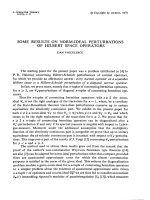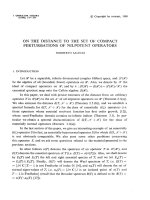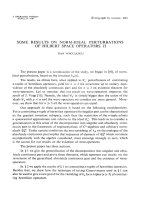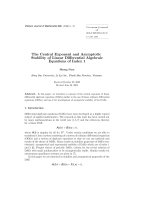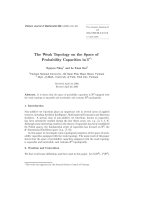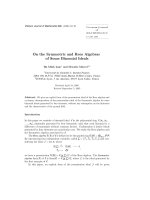Báo cáo toán học: "There are ternary circular square-free words of length n for n ≥ 18" doc
Bạn đang xem bản rút gọn của tài liệu. Xem và tải ngay bản đầy đủ của tài liệu tại đây (83.95 KB, 7 trang )
There are ternary circular square-free words of length
n for n ≥ 18.
James D. Currie
∗
Department of Mathematics and Statistics
University of Winnipeg
Winnipeg, Manitoba
Canada R3B 2E9
Submitted: March 18, 2002 Accepted: October 11, 2002.
MR Subject Classifications: 05B45, 05B30, 11B99
Abstract
There are circular square-free words of length n on three symbols for n ≥ 18. This
proves a conjecture of R. J. Simpson.
Keywords: Combinatorics on words, square-free words
1 Introduction
The word hotshots can be written as (hots)
2
.Wethuscallhotshots a square
1
.Onthe
alphabet {0, 1} the longest words not containing squares are 010 and 101. On the other
hand, at the beginning of the last century, Thue [9] proved that over {0, 1, 2} there is an
infinite squarefree word, i.e. an infinite sequence not containing any squares.
Variations on the problem of finding squarefree words have included finding infinite
squarefree tilings [2], or finding infinite squarefree walks on graphs and digraphs [3, 4].
The problem of finding an infinite squarefree tiling can be viewed as that of finding a
coloring of the lattice graph of the tiling on which certain walks give squarefree colour
sequences. For example one may ask for colourings of the infinite checkerboard with
finitely many colours, such that rook or bishop moves always trace squarefree words [5].
A recent paper of Alon et al. [1] looks for colourings of finite graphs such that all
cycle-free walks give squarefree sequences of colours. Let C
n
be the cycle on n vertices.
They offer the following conjecture.
∗
This work was supported by an NSERC operating grant.
1
Thanks to J. Shallit for this interesting natural square.
the electronic journal of combinatorics 9 (2002), #N10 1
Conjecture 1.1 For n ≥ 18, there is a colouring of C
n
with 3 colours such that every
cycle-free walk gives a square-free word.
The conjecture is several years old, and appears to be due to R. Jamie Simpson.
One checks by computer that the result of the conjecture holds for 1 ≤ n ≤ 179, with
exceptions at n =5, 7, 9, 10, 14 and 17. We establish the conjecture by proving the
existence of circular squarefree words for n ≥ 180.
2 Preliminaries
Awordw is squarefree if it is impossible to write w = xyyz with y anon-emptyword.
Word v is a conjugate of word w if there are words x and y such that w = xy and v = yx.
We say that w is a circular squarefree word if all of its conjugates are squarefree.
Example 2.1 The set of conjugates of word 123 is {123, 231, 312}.Eachoftheseis
squarefree, so 123 is a circular squarefree word. On the other hand, 1231213 is squarefree,
but its conjugate 3123121 starts with the square 312312. Thus 1231213 is not a circular
squarefree word.
Our main result is the following:
Main Theorem For each n ≥ 18 there is a word over {0, 1, 2} of length n which is
circular square free.
If u and v are words, we write u ≤ v (equivalently, v ≥ u)ifu is a subword of v,that
is, if v = xuy for words x and y. We write u ≤
p
v (equivalently, v ≥
p
u)ifu is a prefix of
v,thatis,ifv = uy for some word y. Again, we write u ≤
s
v (equivalently, v ≥
s
u)ifu
is a suffix of v,thatis,ifv = xu for some word x.
Remark 2.2 If uavbw ≤ xx then a ≤ x or b ≤ x.
Our constructions deal with binary words, i.e. strings over {0, 1}.If
w is a binary word we denote by
w the binary complement of w, obtained from w by
replacing 0’s with 1’s and vice versa. For example,
01101001 = 10010110.
If w is a word, we denote by |w| its length, that is, the number of letters in w.Thus
|01101001| =8. Ifa is a letter, we denote by |w|
a
the number of occurrences of a in w.
Thus |01101001|
0
=4.
3 A few properties of the Thue-Morse word
The Thue-Morse [8, 9] sequence t is defined to be t = h
ω
(0) = lim
n→∞
h
n
(0), where
h : {0, 1}
∗
→{0, 1}
∗
is the substitution generated by h(0) = 01, h(1) = 10. Thus
t = 01101001100101101001011001101001 ···
the electronic journal of combinatorics 9 (2002), #N10 2
Every subword of t is a subword of h
n
(0) for some n. Therefore, every subword of t
appears in t infinitely often. Let us write
t = t
0
t
1
t
2
t
3
t
4
···
where the t
i
∈{0, 1}. It follows from the definition that t
m
= t
m+1
if m is even.
A ternary square-free sequence s results from counting 1’s between subsequent 0’s in
t:
s = 210121020120210 ···
Sequence s has the property that 010 and 212 are not among its subwords. Also, word s
inherits from t the property that any subword of s appears in s infinitely often.
Remark 3.1 Suppose that u is a subword of t such that u begins and ends with 0.
Counting 1’s between subsequent 0’s in u gives a subword v of s. We find that |v| = |u|
0
−1.
Lemma 3.2 Let n be an integer, n ≥ 2.Wordt contains a subword of the form a
avbb
where a, b ∈{0, 1} and |a
av| = n.
Proof: If n is even, the subword t
n
t
n+1
t
2n
t
2n+1
will do, since t
n
= t
n+1
, t
2n
= t
2n+1
.
If n is odd, the subword t
3
t
4
t
n+3
t
n+4
will do.
Since the set of subwords of t is closed under binary complementation, we have the
following corollary:
Corollary 3.3 Let n be an integer, n ≥ 2. Either t contains a subword of the form 10v10
with |10v| = n, or a subword of the form 10v01 with |10v| = n.
4 Proof of Main Theorem
Remark 4.1 Suppose word 10v
2
10 is a subword of t, and consider the word s
2
obtained
by counting 1’s in h
3
(10v
2
10) = 1001011001101001h
3
(v
2
)1001011001101001. Thus s
2
has
the form 0120210u
2
0120210, and contains a subword of s of the form 0210u
2
0120 of length
4|v
2
| +9.
Similarly, suppose word 10v
1
01 is a subword of t. Consider the word s
1
obtained by
counting 1’s in h
3
(10v
1
01) = 1001011001101001h
3
(v
1
)0110100110010110. Thus s
1
has
the form 0120210u
1
2102012, and contains a subword of s the form 0210u
1
2102 of length
4|v
1
| +9.
Combining this remark with Corollary 3.3, we have the following Theorem:
Theorem 4.2 For every n ≡ 1 (mod 4), n ≥ 9, either s has a subword of the form
u = 0210w2102, |u| = n or a subword of the form u = 0210w0120, |u| = n.
Claim 4.3 If u = 0210w2102 is a subword of s, then s will contain the subword 012u012.
In fact, the only subword of s of the form vuw with |v| = |w| =3is 012u012. In particular,
the word 12u01 is square-free.
the electronic journal of combinatorics 9 (2002), #N10 3
Sketch of Proof: Evidently, 0u commences with the square 00, so that 0u doesn’t appear
in s. On the other hand, if the word 1u appears in s, then either 21u or 01u is a subword
of s; the first of these starts with the repetition 210210, while the second contains 010,
which is not a subword of s. Since neither 0u nor 1u can appear in s,2u must appear in
s.
An easy (but lengthy) continuation of this argument establishes the claim.
Similarly, one verifies the following:
Claim 4.4 If u = 0210w0120 is a subword of s, then s will have contain the subword
012u210. In fact, the only subword of s of the form vuw with |v| = |w| =3is 012u210.
In particular, the word 12u21 is square-free.
Remark 4.5 Let ν
0
, ν
1
, ν
2
, ν
3
be the words
ν
0
= 010212010201202101201020120212010212
ν
1
= 0102120102012021012010212
ν
2
= 010212010201202120121012010212
ν
3
= 0102120121012010212.
One checks that for each i, 2102ν
i
0210 is squarefree. Each ν
i
contains 010212 exactly
twice, but none of the ν
i
contains 2102 or 2120210. The shortest suffix of one of the ν
i
to contain the word 0210 is suffix 021012010212 of ν
1
, of length 12. Whenever word 0210
occurs in one of the ν
i
it is in the context 021012010. The longest of the ν
i
is ν
0
,oflength
36.
Here |ν
0
| =36≡ 0(mod4),|ν
1
| =25≡ 1(mod4),|ν
2
| =30≡ 2(mod4),
|ν
3
| =19≡ 3(mod4).
Theorem 4.6 Let u be a subword of s of the form u = 0210w2102, |u|≥4|ν
0
|. Then for
each i, uν
i
is a circular squarefree word.
Proof: Suppose not. We form 4 cases based on which conjugate of uv contains a square:
1. xx = v
2
uv
1
, v
2
≤
s
ν
i
, v
1
≤
p
ν
i
, |v
1
v
2
|≤|ν
i
|.
2. xx = u
2
ν
i
u
1
, u
2
≤
s
u, u
1
≤
p
u, |u
1
u
2
|≤|u|.
3. xx = u
2
v
1
, u
2
≤
s
u, v
1
≤
p
ν
i
, |v
1
v
2
|≤|v|.
4. xx = v
2
u
1
, v
2
≤
s
ν
i
, u
1
≤
p
u.
the electronic journal of combinatorics 9 (2002), #N10 4
Case 1: We have xx = v
2
uv
1
. Since 012u012 is a subword of s,word12u01 is squarefree.
We must therefore have one of |v
1
|,|v
2
|≥3. Also, |x|≥|u|/2 ≥ 2|ν
i
|≥2|v
i
|, i =1, 2. We
can thus write x = v
2
u
1
= u
2
v
1
, where u = u
1
u
2
, |u
i
|≥|x|/2 ≥|v
j
|, i =1, 2; j =1, 2. If
|v
1
|≥3thenv
2
u
1
= u
2
v
1
implies that 010 ≤
p
v
1
≤ u
1
≤ s. This is impossible, as 010 is
not a subword of s.If|v
2
|≥3 then 212 is a subword of s.Thus|v
1
|,|v
2
|≤2, which is a
contradiction.
Case 2: We have xx = u
2
ν
i
u
1
. However, ν
i
, and hence xx, contains subword 010212
exactly twice. By Remark 2.2, 010212 will be a subword of x.
By Remark 4.5 2102ν
i
0210 is square-free, so that one of |u
1
|, |u
2
|≥5. If |u
2
|≥5,
then 2102010212 appears in the first x of xx. Since the second 010212 in xx is a suffix of
ν
i
, the second occurrence of 2102010212 in xx will be a subword of ν
i
,sothatν
i
contains
2102, contradicting Remark refnu 0 to 3. We get a similar contradiction if |u
1
|≥5, when
2120210 ≤ ν
i
.
Case 3: We have xx = u
2
v
1
. We may assume that |v
1
|≥3; otherwise xx would be a
subword of the square-free word u01 ≤ 12u01. Similarly, |u
2
|≥5, since 0120ν
i
is non-
repetiitive. Finally, |u
2
| < |v
1
|. Otherwise, 010 ≤ v
1
≤ x ≤ u
2
≤ s, which is impossible.
Now, however, 2102 ≤ u
2
≤ x ≤ v
1
≤ ν
i
, which is impossible by Remark 4.5.
Case 4: We have xx = v
2
u
1
.Here5≤|u
1
| < |v
2
|.Since|u
1
|≥5, 0210 ≤ u
1
≤ x ≤ v
2
.
Write x = v
3
= v
4
u
1
= v
4
0210u
2
. ByRemark4.5,12≤|0210v
6
| = |x|.If|v
4
|≥3,
then v
3
contains 2120210, contradicting Remark 4.5. On the other hand, if |v
4
|≤2, then
|u
1
| = |x|−|v
4
|≥10. It follows that some word 0210z, |z|≥6isasubwordofu
1
,and
hence of v
3
. The prefix of length 9 of 0210z appears in ν
i
, and must thus be 021012010.
This means that 010 ≤ 0210z ≤ u
1
, which is impossible.
Remark 4.7 Let µ
0
, µ
1
, µ
2
, µ
3
be the words
µ
0
= 212010201202101201021012021201210212
µ
1
= 2120102012021012102010212
µ
2
= 212010201202101201021201210212
µ
3
= 2120102012102010212.
One checks that for each i, 0120µ
i
0210 is squarefree. Each µ
i
contains 212 either two
or three times. None of the µ
i
contains 2120210 as a subword. The only appearance of
0120212 in one of the µ
i
is in the context 01021 0120212 012 in µ
0
.
Each µ
i
has a prefix 212010, but contains no other 212010. Words µ
1
and µ
3
contain
010212 only as a suffix. The shortest prefix of one of the µ
i
to contain 212 twice is µ
3
,of
length 19. No suffix of µ
i
of length 14 or less contains 0210 as a subword. Every suffix of
µ
i
of length 11 or more contains a word of form 010a212 or 212a212 for some a.
Finally, for each i, |µ
i
| = |ν
i
|.
the electronic journal of combinatorics 9 (2002), #N10 5
Theorem 4.8 Let u be a subword of s of the form u = 0210w0120, |u|≥4|µ
0
|. Then for
each i, uµ
i
is a circular squarefree word.
Proof: Suppose not. Again we form 4 cases:
Case 1: If xx = v
2
uv
1
then 212 is a subword of s.
Case 2: We have xx = u
2
µ
i
u
1
.
Here, x must contain 212 exactly once, while one of |u
1
|, |u
2
|≥5. If |u
1
|≥5, then
2120210 appears in the second x of xx. The first occurrence of 2120210 in xx will be a
subword of µ
i
, contradicting Remark 4.7.
If |u
2
|≥5, then 0120212 is a subword of x, and hence of µ
i
. The second occurrence
of 212 in µ
0
lies in the second x of xx. However, the third 212 of µ
0
will also lie in this
second x of xx, contradicting the fact that x contains 212 exactly once.
Case 3: We have xx = u
2
v
1
. We may assume that 5 ≤|u
2
| < |v
1
|.
We have 212010 ≤
p
v
1
. Write x = u
2
v
3
= v
4
.Wemusthave|v
3
| > 3; otherwise
u
2
≥ 010, which is impossible. This means that 212 ≤ v
3
,andv
1
contains 212 twice.
Thus |v
1
|≥19.
On the other hand, |v
3
|≤5, or else 212010 appears twice in µ
i
. This means that
|v
4
|≥19 − 5 = 14. This implies |u
2
| = |v
4
|−|v
3
|≥14 − 5=9.
Since |u
2
|≥9, word v
4
contains a subword z0120212 where |z| =5.
By Remark 4.7, z is completely determined here; z = 01021. Now, however, 010 ≤
z ≤ u
2
, which is impossible.
Case 4: We have xx = v
2
u
1
. Again |v
2
| > |u
1
|≥5.
We have 0210 ≤
p
u
1
≤ v
2
.FromRemark4.7|v
2
| > 14. Since |v
2
|≥11, word v
2
contains a subword 010a212 or 212a212. It follows from Remark 2.2 that x must contain
010 or 212. In particular, x is not a subword of s.
Write x = v
4
= v
3
u
1
.Wemusthave|v
3
|≤2. Otherwise µ
i
≥ v
4
= v
3
u
1
≥
s
2120210,
contradicting Remark 4.7. Since |v
3
|≤2, x = v
3
u
1
≤ s. This is a contradiction.
Theorem 4.9 For any length n ≥ 180 there is a c ircular square-free word of length n
over {0, 1, 2}
Proof: Let n ≥ 180 be given. Let r be the least residue of n−1 (mod 4). Let m = n−|ν
r
|.
Then m ≡ n − r ≡ n − (n − 1) ≡ 1 (mod 4). Also, m ≥ n −|ν
0
|≥180 −36 = 144 = 4|ν
0
|.
By Theorem 4.2, we can find a subword u of s such that |u| = m, and of the form
u = 0210w2102 or the form u = 0210w0120. If u = 0210w2102, let W = uν
r
.If
u = 0210w0120, let W = uµ
r
. By the preceding two theorems, W will be a circular
square-free word, and |W | = |u| + |ν
r
| = m + |ν
r
| = n −|ν
r
| + |ν
r
| = n.
Combining this theorem with a computer search for n<180 gives the Main Theo-
rem.
References
[1] Noga Alon, Jaroslaw Grytczuk, Mariusz Haluszczak & Oliver Riordan, Non-repetitive
colorings of graphs, Random Structures and Algorithms 21, Issue 3-4, (2002).
the electronic journal of combinatorics 9 (2002), #N10 6
[2] Dwight R. Bean, Andrzej Ehrenfeucht & George McNulty, Avoidable Patterns in
Strings of Symbols, Pacific J. Math. 85 (1979), 261–294.
[3] James D. Currie, Non-repetitive walks in graphs and digraphs, PhD thesis, University
of Calgary (1987).
[4] James D. Currie, Which graphs allow infinite non-repetitive walks? Discrete Math.
87 (1991), 249–260; MR 92a:05124.
[5] James D. Currie & R. Jamie Simpson, Non-repetitive tilings, Electronic Journal of
Combinatorics 9(1), R28 (2002).
[6] Earl D. Fife, Binary sequences which contain no BBb, Trans. Amer.
Math. Soc. 261 (1980), 115–136; MR 82a:05034
[7] M. Lothaire, Combinatorics on Words, Encyclopedia of Mathematics and its Appli-
cations vol. 17, Addison-Wesley, Reading Mass. (1983).
[8] Marston Morse & Gustav A. Hedlund, Symbolic dynamics I, II, Amer. J. Math. 60
(1938), 815–866; 62 (1940) 142; MR 1, 123d.
[9] Axel Thue,
¨
Uber unendliche Zeichenreihen, Norske Vid. Selsk. Skr. I. Mat. Nat. Kl.
Christiana (1906), 1–22.
the electronic journal of combinatorics 9 (2002), #N10 7
